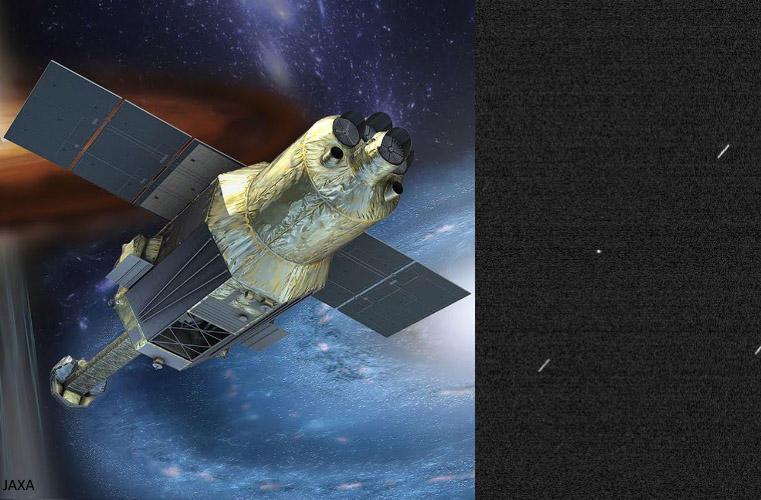Watching a Spacecraft Wreck Tumble Through Space

On a clear night sky, you might spot an occasional shooting star or even glimpse the fast-moving International Space Station as it circles the Earth.
But there are a lot of other objects up there too, including a massive new Japanese x-ray telescope called Hitomi that broke up a few weeks ago, and hundreds of tiny four-inch cube-shaped satellites ("cubesats") that are filling an ever more crowded orbital playground.
VIDEO: 'UFO' Flies Past ISS: Space Junk or Tribble Invasion
Now a group of astrophysical researchers say they can track bits of broken satellites and space junk using regular optical telescopes to record flashes of sunlight that reflect off these wandering probes. This week, they have been watching several big chunks of Hitomi as they tumble uncontrollably through space.
"As these things are going across the sky, they flash as the sunlight reflects on them," said Aroh Barjatya, associate professor of engineering physics at Embry-Riddle Aeronautical University in Daytona Beach, Fla. "Using photometry, we wrote a piece of code that centers them and measures the brightness of the object. When you are looking at controlled satellite, the brightness curve behaves in a known way. When you look at Hitomi, it's tumbling up and down. It has spin rate."
The team shot this video of one chunk of Hitomi flashing as stars pass by using a high-speed camera mounted on a telescope, and this video of the main body of Hitomi.
"It's as if a mirror were spinning in space," said Forrest Gasdia, a graduate student at Embry-Riddle, who made the observations this month.
Breaking space news, the latest updates on rocket launches, skywatching events and more!
NEWS: An Orbital 'Pac-Man' to Chomp Through Space Junk?
Barjatya said the group's observatory is specializing in tracking small cubesats -- many of them inexpensive, short-lived probes launched by university researchers that might fall through the cracks of the Pentagon's space junk tracking system.
"There are hundreds of universities launching them each year," Barjatya said. "We are potentially putting a lot of orbiting objects in the sky, many can breakup and fail and destroy other satellites. It hasn't happened. But as we put more and more up there, there is that possibility."
Barjatya says that half of the cubesats have lost contact with their operators. With a better optical tracking system, he hopes that provide more information about their fate.
The Pentagon's Joint Space Operations Center at Vandenberg Air Force Base is currently tracking 23,000 objects in space using radar and optical cameras. Their position are posted on this website each day.
JSpOC spokesman Capt. Nick Mercurio agreed that the space above Earth is getting more crowded. Every day, more than 3,000 automated messages are sent out to satellite operators about drifting debris or other satellites that may pose a risk. JSpOC is currently tracking 11 separate pieces of Hitomi since its breakup on March 26, Mercurio said, and has made five notifications warning other spacecraft operators that these bits are getting close to existing satellites.
PHOTOS: Satellite 'Flock' Launched From ISS Cubesat Cannon
In 2015, nearly 150 satellites had to be moved from their orbit to avoid colliding with something else. Astronauts aboard the ISS had to boost its orbit four times last year to avoid trouble.
"Low earth orbit is congested," Mercurio said. "Things are moving at 17,500 miles per hour and it can get dangerous. A two-centimeter ball bearing has same impact (energy of a) Jeep Wrangler driving at 70 miles per hour."
The Embry-Riddle team says they hope to improve their imaging capabilities with spectroscopic cameras that will be able to analyze the light reflecting off the space debris to determine whether it's a solar panel, piece of Teflon, aluminum or other kind of metal.
This article was provided by Discovery News.
Eric Niiler is a science and climate reporter at The Wall Street Journal, as well as a writing lecturer at Johns Hopkins Advanced Academic Programs and a contributor to many other places such as National Geographic, the Washington Post, and more. He also has an interest in artificial intelligence and its applications in scientific and medical research. Eric has a master's degree in Science and Medical Journalism from Boston University and a Bachelor's degree in Comparative Literature from the University of California, Berkeley.
